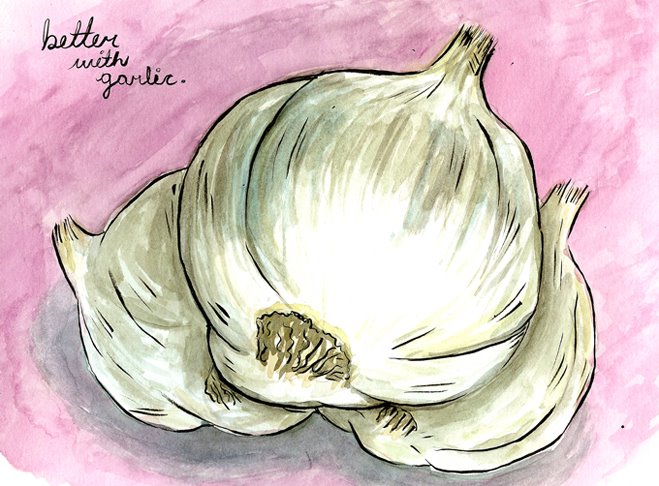Of the three homemade gifts I made for this past holiday season (previously seen here and here), this one was by far the most complicated, but is by no means difficult. Like most canning projects it is necessary to get all of your equipment and ingredients in order and ready to go when you start in order to facilitate the process and, in general, not frustrate the heck outta yourself or get hot jelly on your fingers. That last part might happen anyway. I really enjoyed the end result (there was a little extra) and I also really liked reading through the Ball Home Preserving book. Though I’ve only made one of the recipes from it, I’m intrigued by many of the others, especially the pickles. Give this jelly a try. Like most savory jellies, it is really good poured over cream cheese and served with crackers, but it is also good as an addition to sandwiches and as a glaze for grilled meats.
Roasted Garlic Jelly from The Ball Complete Book of Home Preserving:
Makes 4 half-pint jars
3 medium heads garlic
1 Tb. olive oil, divided
1 Tb. balsamic vinegar, divided
1 c. dry white wine
2/3 c. water
½ c. white balsamic vinegar
1 tsp. whole black peppercorns, crushed
3 Tb. lemon juice
3 c. granulated sugar
2 3 oz. pouches liquid pectin
Preheat oven to 425 degrees. Using a sharp knife, cut off the tops of garlic heads, exposing cloves. Place each head on a small square of aluminum foil set on a baking sheet. Top each head with 1 tsp. olive oil and 1 tsp. balsamic vinegar. Scrunch foil loosely around garlic heads. Make sure to cover the tops or the vinegar will burn off quickly and it’ll make the peeling part later more of a pain, as I learned. Roast in oven until garlic is golden and very soft, 45 to 60 minutes. Let stand until cool enough to handle. Separate cloves, pinching each one to extract the soft roasted garlic. Discard skins. It might get messy here. It’s worth it.
In a medium stainless steel saucepan, combine roasted garlic, wine, water, white balsamic vinegar, and peppercorns. Bring to a boil over medium heat. Reduce heat and boil gently for 5 minutes. Cover, remove from heat and let steep for 15 minutes.
Transfer garlic mixture to a dampened jelly bag or strainer lined with several layers of cheesecloth set over a deep bowl. I went the cheesecloth route. Let drip, undisturbed, for about 30 minutes. Measure 1 2/3 cups garlic juice. If you do not have the required amount (like me) add up to ¼ cup dry white wine or water. Meanwhile, prepare canner, jars, and lids (see here and here and get a canning book!)
Transfer garlic juice to a large, deep stainless steel saucepan. Stir in lemon juice and sugar. Over high heat, stirring constantly, bring to a full rolling boil that cannot be stirred down. Stir in pectin. Boil hard, stirring constantly, for 1 minute. Remove from heat and quickly skim off foam.
Quickly pour hot jelly into hot jars, leaving ¼” headspace. Wipe rim. Center lid on jar. Screw band down until resistance is met, then increase to fingertip tight.
Place jars in canner, ensuring that they are completely covered with water. Bring to a boil and process for 10 minutes. Wait 5 minutes, then remove jars, cool, and store.
For my very first attempt at jelly, I was really pleased. It came out exactly the way I wanted it to and it tasted great. It was well worth the time at the end when it felt like everything was going to fall apart with the boiling and stirring and skimming, but it all worked out. I would definitely make this again.
And thus, finally, concludes the homemade gift giving I did this year. Hopefully in the future I’ll be faster about posting things like this. Hopefully. At the very least I’m glad I was able to share (digitally) some tasty gifts.
.jpg)



















